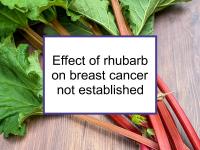Rhubarb (Rheum rhabarbarum) contains some vitamin C, vitamin K, and dietary fiber. Rhubarb also contains cyanidin-3-O-rutinoside, rhein, and some ferulic acid, which have been shown to have some anticancer activities. Rhubarb has been shown to have anti-inflammatory, anti-atherosclerosis and plaque-stabilizing actions in laboratory animals.
The color of rhubarb stalks can vary from red (the most common), to speckled light pink, to light green, all of which are edible. Rhubarb leaves should not be consumed since they are poisonous.
Cancer-related effects of eating rhubarb
Rhubarb contains the polyphenol (Z)-3,5,4-Trimethoxystilbene, a resveratrol analog that has been shown to arrest the growth of human colon cancer cells in a dose dependent manner. Piceatannol, another polyphenol in rhubarb, has been shown to exert immunosuppressive, antileukemic, and antitumorigenic activities, including inhibition of the proliferation of human bladder and prostate cancer cells. Rhubarb stalk extract has been shown to inhibit proliferation of hormone receptor positive (ER+/PR+) breast cancer cells.
The most abundant anthraquinone of rhubarb, emodin (which has traditionally been used as a laxative) has been shown to induce apoptosis in human pancreatic, liver, prostate and breast cancer cell lines. Rhein, another component of rhubarb, has been found to induce apoptosis of nasopharyngeal cancer cells. Because rhubarb typically does not comprise a large portion of the diet of any group of people, there are no population-based studies that specifically isolate any associations between consuming rhubarb and the risk of cancer.
Additional comments
Rhein, a constituent of rhubarb, is the major component of several traditional Chinese herbal medicines, including laxatives and stomach remedies. Rhein herb-drug interactions, especially cytochrome P450 (CYP)-mediated interactions, may cause an enhancement or attenuation in the efficacy of prescription drugs. Rhein can cause liver toxicity at large doses or with chronic use.
There are some available rhubarb-based herbal remedies designed to treat menopausal symptoms in women and containing the phenolic gallylglucoside lindleyin. Lindleyin is a phytoestrogen which has demonstrated estrogenic activity. We recommend against using such remedies for breast cancer patients, survivors and those at high risk for breast cancer since their safety has not been demonstrated. Rhubarb should not be consumed by pregnant women since it may trigger uterine contractions.
Consuming large amounts of rhubarb to obtain the possible benefit of its anticancer components would be impractical since a great deal of sweetener is required to counteract rhubarb's sourness and since the gastrointestinal effects could be overwhelming. However, we would not recommend consuming concentrated rhubarb extracts or pills since their safety and efficacy have not been established.
Essiac tea
Turkish rhubarb root (Rheum palmatum), an herb related to common rhubarb, is a component of Essiac tea, a herbal tea sometimes used as a cancer treatment, primarily for prostate cancer, but also for breast cancer. Essiac also contains red clover, whose isoflavones have estrogenic properties. While the tea has been shown in the laboratory to have potent antioxidant and DNA-protective activity, one careful study found no observable action of Essiac tea against prostate cancer cells. Essiac tea has been shown to stimulate both ER+ and ER- breast cancer cell growth.
Sources of information in this webpage
The information above, which is updated continually as new research becomes available, has been developed based solely on the results of academic studies. Clicking on any of the underlined terms will take you to its tag or webpage, which contain more extensive information.
Note that while we are continually searching for new evidence specifically concerning this food, there is not much interest in it among breast cancer researchers, so few studies specific to rhubarb are available.
